Last week, the Army News Service released this story about the equipment developed under the Soldier Protection System program.
During the development effort, this is a full size poster, PEO Soldier was using to demonstrate the SPS concept. It will give you a good idea of what we’re talkingaboit.
They’re working on new posters with the gear they selected during the development process. Here are some images from that photo shoot, from PM SCIE’s Facebook page.
Below, in the Army’s article, you’ll get a glimpse of the equipment they actually selected. They’re also featuring the Integrated Head Protection subsystem which took an extremely long time to downselect. Although they’re showing this particular helmet off, don’t forget, the Army just awarded a contract to Revision for the ACH II. Although it’s no slouch, lowering the weight of the helmet by 24% at the same ballistic performance of the ACH, it doesn’t have all of the bells and whistles of the SPS helmet. You won’t be seeing this helmet anytime soon.
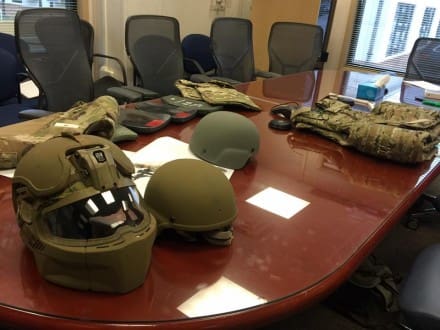
This photo showing the SPS IHPs as well as the ACH is from the PM SCIE Facebook page.
In fact, delays are a common issue with this program. Much of this has to do with some questionable decisions. From its outset, SPS was on, then off, then on again. Once it was under way, requirements were altered by PEO Soldier after the Torso and Extremity Protection’s subsystem candidates were submitted by industry, lowering them in order to allow the government submission to win. Even then, the government’s winning system lacked the required female variant, which is allegedly still under development. There were other issues with the baseline system but its very production has been delayed due to contract protests. Worse yet, there have been acceptance test failures of its protective armor. Furthermore, production of the Ballistic Combat Shirt was delayed due to protests.
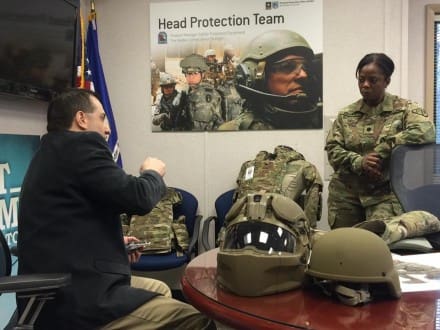
LTC Kathy Brown meets with Army News Service. (Photo from PM SCIE Facebook Page)
Like any organization, they have their triumphs and their failures, but PEO Soldier long ago stopped responding to my requests for information, after I published a series of articles critical of their mishandling of the camouflage and SPS efforts. Program Manager, Soldier Protective Equipment LTC Kathy Brown has met with several reporters regarding this system but they won’t answer the most important question…”why?” Why did they make those choices? Several vendors offered turnkey solutions. The Army has spent two years trying to get their government owned design on the street.
Don’t get me wrong. I want to see them succeed. I’m a former Soldier myself and this equipment is designed to protect the lives of Americans; that’s precisely why I want to see them get it right.
New Soldier armor weighs less, offers more options
WASHINGTON (Army News Service) — The average generation II improved outer tactical vest weighs about 26 pounds. But the new torso and extremity protection system or TEP, under development now at Program Executive Office Soldier, sheds about five pounds of weight and also adds a wide degree of scalability that commanders can make use of depending on threat level and mission.
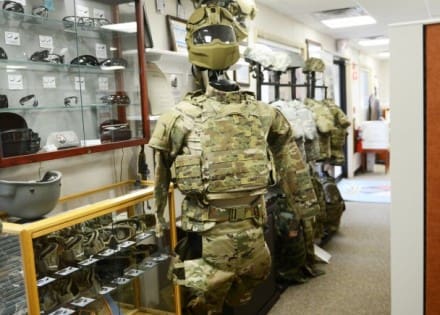
The Torso and Extremity Protection System” or TEP, under development now at Program Executive Office Soldier, sheds about five pounds of weight from the IOTV, and also adds a wide degree of scalability that commanders can make use of depending on threat level and mission. (Photo Credit: C. Todd Lopez)
The TEP is part of the new Soldier Protection System under development now at PEO Soldier. The SPS includes both the TEP and the integrated head protection system.
RANGE OF OPTIONS
The TEP can replace the IOTV, at less weight and greater scalability, depending on the mission. It includes the modular scalable vest, the ballistic combat shirt, the blast pelvic protection system, and a battle belt, which is aimed at getting weight off a Soldier’s shoulders and onto the hips.
With the TEP, commanders can require Soldiers to go with full protection — which provides the same level of protection as a fully-loaded IOTV — or go all the way down to wearing soft armor under their uniforms for missions that require less protection.
“It’s about giving commanders on the battlefield the ability to use the modularity capability of the equipment to fit their particular mission profile or protective posture level,” said Lt. Col. Kathy Brown, the product manager for Personal Protective Equipment at PEO Soldier, Fort Belvoir, Virginia.
BALLISTIC COMBAT SHIRT
The IOTV sometimes required Soldiers to wear the deltoid auxiliary protection — cumbersome parts that snapped on to the IOTV and protected their shoulders. Soldiers might have also been asked to wear the smaller, easily-lost collars that also snapped on to the IOTV. Both are gone with the TEP. They’ve been replaced by the ballistic combat shirt, which is a shirt with breathable fabric and which also includes those smaller ballistic protection parts built in. Soldiers would wear the BCS under the TEP’s modular scalable vest.
“We have tested it,” Brown said of the ballistic combat shirt. “Soldiers like it. There is 95 percent Soldier acceptability of it. What we are working on now is tweaking the sizes.”
NEW PELVIC PROTECTION
The TEP also includes the blast pelvic protection system, which is designed to protect a Soldiers thighs and groin against ballistic threats and burns. The BPPS is meant to replace the current combination of the pelvic undergarment and the pelvic outer-garment, or “PUG” and “POG.” The PUG has sometimes been referred to as “ballistic underwear.”
Brown said the BPPS “provides the same level of protection” as the PUG and POG combined, including both burn and fragment protection. She said Soldiers have reported that it feels more like it is “part of the pants.”
BELT TAKES LOAD OFF SHOULDERS
The battle belt included with the TEP is part of a weight management system, but it also offers some protection as well.
“It’s designed to remove the weight from your shoulders and put it on your hips,” Brown said. Whereas Soldiers might strap a radio or other gear onto their IOTV in the past, the battle belt can now take that gear and move the weight onto a Soldier’s hips.
Brown said that after successful ballistic testing, production of the TEP will begin in probably May of this year, and that Soldiers could see it in 2018 or 2019.
NEW HELMET
Another part of the Soldier Protection System is the integrated head protection system, or IHPS. In its full configuration, it looks similar to a motorcycle helmet.
The IHPS consists of a base helmet, similar to the polyethylene enhanced combat helmet that some Soldiers are already wearing. The IHPS also includes add-ons for the base helmet, including a visor, a “mandible” portion that protects the lower jaw, and a “ballistic applique” that is much like a protective layer that attaches over the base helmet. The complete ensemble is known as the “high threat configuration.”
Brown said that eventually all deploying Soldiers will get the IHPS with the base helmet, which is the standard configuration. Other Soldiers, vehicle gunners in particular, will also get the mandible portion and the ballistic applique as well, known as the turret configuration.
The IHPS currently has a Picatinny rail mounted on the side for attaching gear, and will also provide for attaching head-mounted night vision goggles.
NEW SUNGLASSES
The visor portion on the IHPS provides ballistic protection to a Soldier’s face but doesn’t provide any protection against the sun. So Soldiers wearing it will need to wear darkened sunglasses underneath the visor if they are in bright environments.
Maj. Jaun F. Carleton, also with PEO Solider, had a pair of new sunglasses that are authorized for use by Soldiers if they want to buy them, or if their commanders buy them for them.
The sunglasses, which also come in a face mask version as well, start off as un-darkened — offering no protection against the sun. But with the press of a button, LCD modules that adhere to the lenses darken and provide protection against the sun. That happens in less than a second.
“The benefit is that using one pair of protective eyewear, you wouldn’t have to switch from a clear goggle to a dark goggle — you’d have one protective eyewear for all conditions,” Carleton said.
Brown said the goggles will be available for units to be able to requisition as part of the Soldier Protection System.
“If we are able to drive the price down, the Army could eventually make a decision to include that on the list of items that we carry for deploying Soldiers,” Brown said.
SOLDIER TESTING
Brown said the IHPS will likely be available to deploying Soldiers sometime between 2020 and 2021.
As part of extensive human factors evaluations, Brown said that PEO Soldier has used Soldiers, extensively, to evaluate the new gear.
“We had a massive scale of Soldiers to evaluate the equipment, usually over a three-week to month-long timeframe, where they would perform their different mission sets, where they will execute basic rifle marksmanship, and ruck marches,” she said.
Afterward, she said, those same Soldiers were asked what they think of the gear through a qualitative evaluation methodology (Soldier survey).
“They would give us the good, the bad, the ugly,” Brown said. “It’s extremely important to get Soldiers’ input. First, Soldiers are brutally honest and they are going to tell you exactly how they feel about the equipment. Second, why buy equipment Soldiers won’t wear? And third, who’s better to give us the best answer about how the kit should be designed than the Soldier who will actually wear the equipment?”



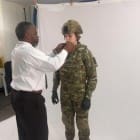
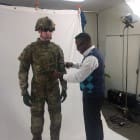
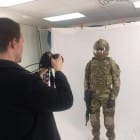
Those goggles are awesome.
LCD eyewear is the future, its going to get better very soon.
Still looking like a school boy trying on daddy’s full combat gear.
Super glad they added a sapi plate to the top of that extended height helmet so it will stop a round when peeking out of cover exposes 7 inches of helmet top
I think our boys manning the turrets on Gun trucks will at least see an incentive to wear that.
That was the only use I could see for that…and a good one at that (just need some neck support)
looks like the commercial version of those electrochroamatic sunglasses can be found at http://www.ctrl-eyewear-shop.com. Ain’t cheap though at $299. Battery life is 70 hours and charges off a micro USB.
We all want better kit… and PEO soldier is definitely trying to get it into the hands of our soldiers. The management of such a large scale program with so many intrigue facets is a daunting task… The process not necessarily the decision needs to come into question… The process to qualify what is good and bad is flawed. While I have been involved with product development for the military for just over a decade, it is very clear that when politics and design by committee are part of the process the result with always be less than great… to many compromises. PEO Soldier has a very difficult task that is only complicated by the hoops they need to jump through… I wish them the best of luck… for the Soldier’s sake!
Protective Outer Garment – POG
Hahaha. Somebody at PEO was CA.
The problem I see with the scalability system is that to many commanders do not take time to learn the the system. I don’t many commanders allowing soldiers to tailor there load based on mission or threats. Too many time you are ordered to wear all your equipment… zero questions asked and no feedback from the soldiers is taken into mind.
look at qual ranges, why am I wear an IOTV without plates to qual in? Oh that’s right we train as we fight, I have fought this mentality as an Infantry NCO for most of my military career and its the same battle year after year. Come back from patrol and barely make it to chow… then to get turned around because your wearing a combat shirt and not in the correct uniform.
Until we correct the way the leadership thinks then how do we actually fix these things…. when I was in CREW master gunner I was told by the cadre that if I was wearing a THOR and had to take cover that I need to extend my antenna straight up so the radiation pattern would still give me coverage.
So I replied so you want me to low crawl with an antenna sticking 3 feet straight above me, needless to say I got the stink eye.
This is the type of thinking that kills the Army and make it hard for soldiers to do the job needed. I hope we get better gear and I hope the management learns to how to properly use it.
Bro, every army has this problem. And trust me, the US Army gets it done in one of the best ways around (maybe New Zealand and Australia do things that make sense too). It’s just a lot of people that take decisions while wanting to look smart instead of learning something for the man on the ground. So while I totally understand you, be aware that you guys are one of the luckiest. The truth is – if one wants a job and gear that make sense – go Special Ops.
I am not complaining about the gear as I am complaining more on how it is used and implemented on the battle field. In 2005/06 we were forced to wear the under arm protectors for our IBA’s, they were terrible uncomfortable and cut air flow to the vest and cut the blood flow to your arms. Why, because someone was shot by a sniper under his arm, now had he had been wearing that soft armor would it have stopped the round… nope But hey we have these so start wearing them.
Groin protectors, had to be on your vest but they did not have to be hanging…hell most soldiers have zero idea how to wear ECWS clothing correctly. I see us get great gear but nobody decides how to implement in in the correct way to help the soldier from Division/Battalion/Company level
I love how the army gear is now. It looks very safe and protective. I think that it’s worth the money to be continually investing and inventing new uniforms and gear that is safer and more efficient for our soldiers.